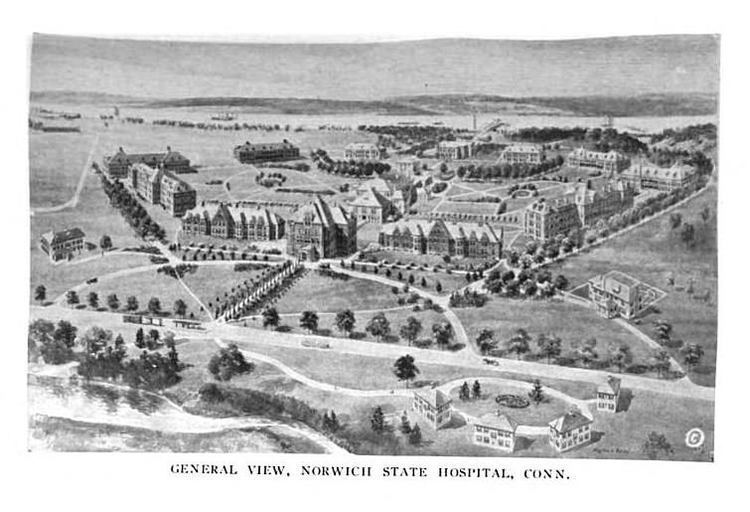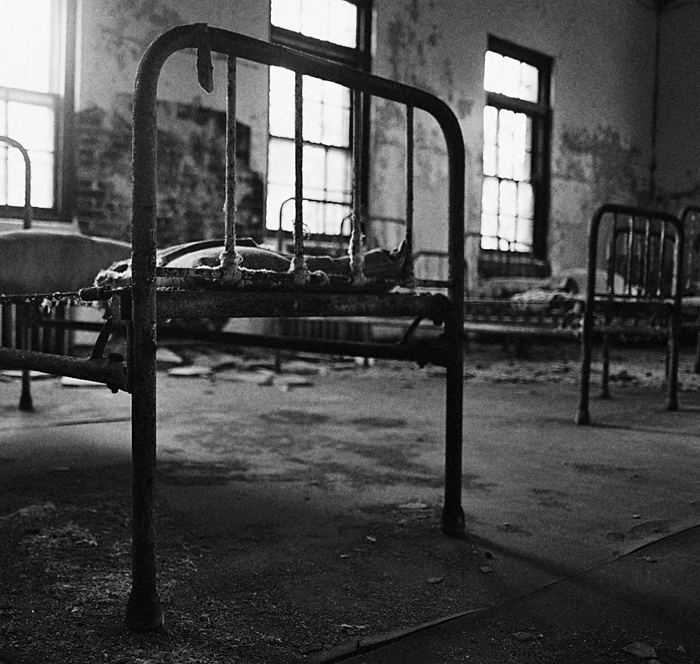Built 1903 Area 28 ha Architecture firm Cudworth & Woodworth Added to NRHP 22 January 1988 | NRHP Reference # 87002424 Opened October 1904 Founded October 1904 | |
 | ||
Similar Danvers State Hospital, The Seaside, Connecticut Valley Hospital, Fairfield Hills Hospital, Philadelphia State Hospital | ||
A land lost the norwich state hospital part 1 of 2
The Norwich State Hospital, originally established as Norwich State Hospital for the Insane and later shortened to Norwich Hospital, is located in Preston and Norwich, Connecticut. It opened its doors in October 1904, and though the number of patients and employees were drastically reduced, it remained operational until October 10, 1996. Norwich State Hospital was a mental health facility initially created for the mentally ill and those found guilty of crimes by insanity. Throughout its years of operation, however, it also housed geriatic patients, chemically dependent patients and, from 1931 to 1939, tubercular patients. The hospital, which sits on the banks of the Thames River, began with a single building on 100 acres (40 ha) of land and expanded to, at its peak, over thirty buildings and 900 acres (360 ha).
Contents
- A land lost the norwich state hospital part 1 of 2
- Abandoned norwich state hospital asylum
- Development of the grounds
- Timeline of changes and patient census 1904 to 1996
- Patient Ward Buildings
- Legacy
- Proposals
- Demolition
- TV appearances
- References

A 70-acre (28 ha) property including the hospital was listed as an historic district on the National Register of Historic Places in 1988.

Abandoned norwich state hospital asylum
Development of the grounds

In October, 1904 when the hospital first opened, it held ninety-five patients and was a single building. The facility quickly outgrew its meager beginnings, and by fall of 1905, it held 151 patients and had expanded its housing by adding two additional buildings. The original building was soon converted to administrative offices. In 1907, a third patient building was opened, and over the next eight years, there would be the addition of thirteen structures to the grounds. The hospital began to branch out, no longer creating housing intended only for patients, but for hospital physicians, a laboratory, an employees club, a main kitchen and various other structures to support the every-day workings of the hospital. Like most mental hospitals at that time, it was self-sufficient, and a barn, two garages, a paint shop and a greenhouse were also added. By the end of the 1930s, over twenty buildings had been added to the grounds.

To provide an identification system, each building was originally assigned a letter name. The original campus had ward buildings grouped in pairs and designated as "North" for female patients or "South" for male patients. Around 1940, each building was given a name in honor of the founding superintendents of the American Psychiatric Association and well-known mental health advocates such as Thomas Story Kirkbride and Dorothea Dix. Later buildings were named after recognized contributors to the hospital, including Connecticut governors Abraham Ribicoff and John Davis Lodge. The Ronald H. Kettle Center opened in 1960 as the new medical-surgical facility and was the largest building on the property. Built like a general hospital, it reflected the then-modern belief that mental illness could be treated biologically on a short-term stay, thus reducing the need for antiquated long-term care wards. The Ribicoff Research Center was built perpendicular to Kettle to facilitate the discovery of new treatment techniques. Gradually, as the number of patients and employees began to decrease, when a new structure was built, an older one would be closed, and by the early 1970s, only 7 of the original buildings were still in use, the others used for either storage or abandoned completely. As the process of deinstitutionalization progressed, a new law required all patients' cases to be reviewed every two years. This, along with threats of strike from the union, lead to the hospital vacating many more of its buildings in 1979. By the time the hospital closed in 1996, only a fraction of the campus was still operating. All patients were now housed in the Kettle building along with geriatric patients in Seymour. The Gallup building continued to house the Boneski Treatment Center for chemical dependency, and other buildings still in use up to closure included Administration, Lodge, Russell, Ribicoff, the Chapel, utility buildings, and employee housing facilities across the street.

Due to the large number to structures and the hundreds of acres they stood on, the majority of buildings were connected by a series of underground passageways. The main purpose of these tunnels were for the utilities, however, they were often used to transport patients from one area to another. In more recent times, the tunnels have become a means of transportation for trespassers who hope to explore the grounds of the hospital undetected by the security officers who have been hired by the state to patrol the vacant site.
Timeline of changes and patient census (1904 to 1996)

Patient Ward Buildings
Legacy
The hospital was listed on the National Register in 1988. The NRHP listing included 40 contributing buildings and two contributing structures on 70 acres. It includes work by architects Cudworth & Woodworth. It includes Colonial Revival and Late Gothic Revival architecture.
The district was deemed historically significant as illustrating a historic view of mental health treatment.
In 1996, when Norwich State Hospital was closed, the State Department of Public Works (DPW) became responsible for the property. In 2005, after several unsuccessful attempts to sell the property, The DPW proposed the sale of 419 acres (170 ha) of the former hospital's campus to the town of Preston, and 61 acres (25 ha) to the town of Norwich for one dollar. Both towns were given three years to close the transfer of the property.
In March, 2009, the town of Preston purchased 390 acres (160 ha) of the property offered to them by the state. In spring of 2009, the Preston Redevelopment Agency was created to oversee the development of the newly acquired property. According to the sale agreement, the state would provide for the security presence, maintenance and insurance of the property until March, 2010, at which point the town of Preston would take responsibility for the cost of these, as well as begin the property cleanup.
Proposals
Since the DPW first made an offer to the town of Preston to purchase a portion of the Norwich State Hospital, several proposals have been submitted for the use of the property. One of the earliest proposals was submitted by Utopia Studios, and was approved in May 2006. Utopia promised an entertainment complex consisting of a theme park, 4,200 hotel rooms, a performing arts school and a movie studio. The projected cost of this project was around $1.6 billion and was viewed favorably by the voters. However, in November of the same year, the proposal was canceled by the town due to Utopia missing several key deadlines and, most importantly, failing to place $53 million in escrow as agreed.
In 2008, two developers, Northlang Investment Corporation and Preston Gateway Partners LLC, sought for approval to develop the land. The town accepted Northland's proposal for a billion-dollar luxury resort, but in November 2008, this plan was ended as well. Since then, eight additional developers have submitted proposals to develop the property, but as of March 2010 no agreement has been reached.
The property, which has become known as the Preston Riverwalk, had been considered for a project by the town's parks and recreation department. This would have included a public access park for bird-watching, fishing and various other outdoor activities. On May 13, 2016, the Mohegan Tribe reached an agreement with Town of Preston to purchase the land. According to the Hartford Courant (http://www.courant.com/business/hc-mohegan-norwich-state-hospital-20160513-story.html), the land will be used "for office, retail, entertainment, recreation and possibly housing." It will not become tribal land, meaning that whatever is built there will be a source of state and local tax revenue.
Demolition
The Norwich State Hospital is listed on both the state and national historic register as a place of architectural and historical significance and thus many of the buildings, grounds, and infrastructure can not be removed (or even cleaned of medical waste material) without exception from both state and federal historical authorities. Nonetheless, demolition of the property started in spring of 2011 with the collapse of the tunnels surrounding Administration. Later that year, Salmon, Awl, and the cafeteria-theater buildings were demolished, followed by Ribicoff, the power plant, chapel, and a few cottages in 2012. As of June 2014, all buildings on the campus have been demolished except for the Kettle, Lodge, Seymour, and Russell Buildings, which are in the process of abatement and demolition, and the Mitchell, Gallup, Lippitt, Ray, and Pathway Buildings, which present special concerns and were expected to be demolished later in 2014. The Administration Building has been weatherized and buttoned up to prevent further decay and will be saved for future development.
Demolition of the site was ongoing in November 2014; the exposed interior including the stairwell of the Kettle building was featured in The Day.
TV appearances
Episodes two and four of season one of VH1's Celebrity Paranormal Project were filmed at the mental hospital though most likely to protect the place it was referred to as Warson Asylum for the Criminally Insane during both episodes.
The Norwich State Hospital was featured in the TV series Life After People, in the episode titled "Crypt of Civilization", which aired on January 19, 2010.
Syfy Channel's Ghost Hunters paranormal investigating team explored the location in their sixth season which aired May 5, 2010.
